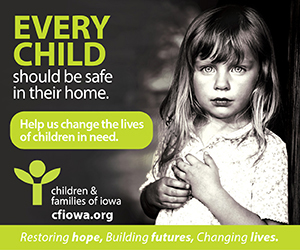The Elbert Files: Racial scar left by freeway

Des Moines has a deep scar on its racial psyche from decisions made 60 years ago to route Interstate 235 through the heart of the city’s Black community.
Wiped out in the process were the homes of hundreds of African Americans along and near Center Street, where Black supper clubs and service businesses thrived in 1958.
Then, like now, the matter of Black lives was oblivious to most white residents.
The Des Moines freeway was a huge deal in 1958. It was the biggest transportation project since the arrival of the railroad in 1866.
The Federal Aid Highway Act of 1956 was President Dwight Eisenhower’s plan for uniting the country with high-speed highways.
People believed the new interstate highways would transform the nation, and they did, although not always for the better.
While the interstate system brought new visitors to the metro area, there was also a downside in that it effectively limited growth within the city, spurred white flight and pushed retail growth to the suburbs.
Newspaper articles in the late 1950s focused on how the freeway would affect white homeowners, businesses and recreation, including Waveland Golf Course and Des Moines Golf and Country Club.
Rarely was there mention of what was then called the “Negro ghetto,” the Center Street area that would be devastated by the plans.
Roughly 400 families on and around Center Street were displaced by the freeway and accompanying urban renewal projects that were poorly conceived and badly administered.
Page 13 of the May 27, 1959, Des Moines Register contained a report on the difficulties Black families had finding comparable housing.
“When I told people I was looking for a house which would cost what the highway commission paid me, they laughed at me,” said a Black resident of the 1000 block of 16th Street.
“We were paid only $5,500 for our three-bedroom house and now are forced to buy a two-bedroom house, not as good for $9,500,” said an African American whose home was located where Martin Luther King Jr. Boulevard now crosses I-235.
Those difficulties should not have surprised anyone. A three-part series in the Des Moines Tribune in 1956 had reported that even without segregation laws, the division of races in Des Moines was “Nearly 100% Effective.”
Tribune reporter Robert Spiegel explained the legal methods used by real estate agents and homeowners to contain the city’s Black community, including refusing to show minority buyers homes outside the inner city and dramatically increasing prices when a Black family wanted to make an offer.
A 35-year-old resident surgeon at Veterans Hospital, who happened to be Black, told of his frustration in trying to buy a home for his wife and three children near the hospital in northwest Des Moines.
“There have been a number of houses for sale that would have suited us, but nobody would sell to us,” the surgeon told Spiegel. “I must have called nearly 80 or 90 realtors and builders.”
Distrust created by the freeway project still lingers in Des Moines’ African American community.
It need not have been that way.
In February 1958, three months before the Iowa Highway Commission approved the Center Street route, Monroe Patzig, a local engineer, suggested an alternative, which he said would be less expensive and involve less “inconvenience.”
Patzig, whose idea was supported by 18 other engineers, suggested running the freeway south of downtown, parallel to the east-west railroad district that already existed. It was similar to a 1920s proposal for a highway south of downtown, and the route was nearly identical to today’s Martin Luther King Jr. Parkway.
Unfortunately, Patzig’s plan was never seriously considered.
To learn more about how the freeway affected Des Moines’ Black community, go to https://www.undesigndsm.com and click on “Gallery to see images of the Center Street area before and during construction of I-235.”







